#Sugar Beet
Text
Napoleon and Sugar Production and Trade
A little bit about how the sugar industry was transformed during the Napoleonic Wars. Specifically, how sugar beet substituted and replaced sugar cane.
From Robert M. Harveson, History of sugarbeets, University of Nebraska-Lincoln, Institute of Agriculture and Natural Resources (source)
“Sugar was only obtained from the tropical sugar cane and was prohibitively expensive for most Europeans. During the early 1800’s most sugar was obtained from the West Indies. After supplies were cut off by the English blockade of continental Europe during the Napoleonic Wars, the demand for sugar grew throughout Europe. Napoleon encouraged new research with sugar beets, and between 1810 and 1815, over 79,000 acres were put into production with more than 300 small factories being built in France.”
From R. N. Dowling, Sugar Beet and Beet Sugar:
“Napoleon I, brought real life into the new industry. As a farsighted statesman, he recognized the great advantages connected with a future beet sugar industry that would produce at home all the sugar needed by his people. For this reason he at once, by a decree of 1812, appropriated 100,000 hectares, or 247,100 acres, exclusively for the cultivation of sugar beets and 1,000,000 francs for experiments in connection with beet raising and sugar extraction.”
The trade war:
“The interest of Napoleon was due to the continental blockade that excluded all products manufactured in England and her colonies from the European markets. As a consequence the price of cane sugar rose to an extraordinary height: it was more than 30 cents per pound in the period from 1807 to 1815. Under such circumstances the erection of beet sugar factories was a very profitable investment of capital and it is, therefore, not to be wondered at that in France, as early as 1812 some 40 factories were in operation, working up 98,813 tons of beets obtained from 16,758 acres, and yielding a total output of 3,300,000 Ibs. of sugar. For the first time in the history beet sugar came to compete with the tropical product. From very modest beginnings in the first quarter of the nineteenth century the beet sugar industry grew to the enormous dimensions of today, crowding out cane sugar from the markets of the European continent and successfully competing with the tropical product in many other countries.”
(From R. N. Dowling)
Long-term impact—Sugar beet today:
“Of the current world production of more than 130 million metric tons of sugar, about 35% comes from sugar beet and 65% from sugar cane. In the USA, about 50-55% of the domestic production of about 8.4 million metric tons derives from sugar beet.”
(From Robert M. Harveson)
#Sugar beet#sugar#beets#beet sugar#napoleon#napoleonic era#napoleonic#napoleon bonaparte#first french empire#french empire#france#Napoleon’s reforms#history#1800s#agriculture#reforms#napoleonic reforms#commerce#trade#economics#economic history#University of Nebraska-Lincoln#Nebraska#sugar cane#Robert M. Harveson#Dowling#Harveson
27 notes
·
View notes
Photo
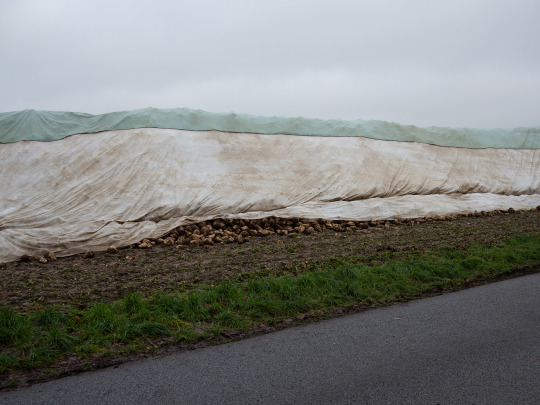
sugar beet harvest – near village in the far west of germany // 12-2017
© 2017 waidwund-photo
#photographers on tumblr#original photographers#agriculture#rural exploration#sugar beet#harvest#abstraction#waidwund photo#josch schlegel#traces of human life
59 notes
·
View notes
Text
It’s that time of year again in mid Michigan-

Time to roll out the big farm equipment-

It is sugar beet harvest time again. We will see these all over the place now. I’ll try and get a picture of the mountains of beets a bit later.
35 notes
·
View notes
Photo
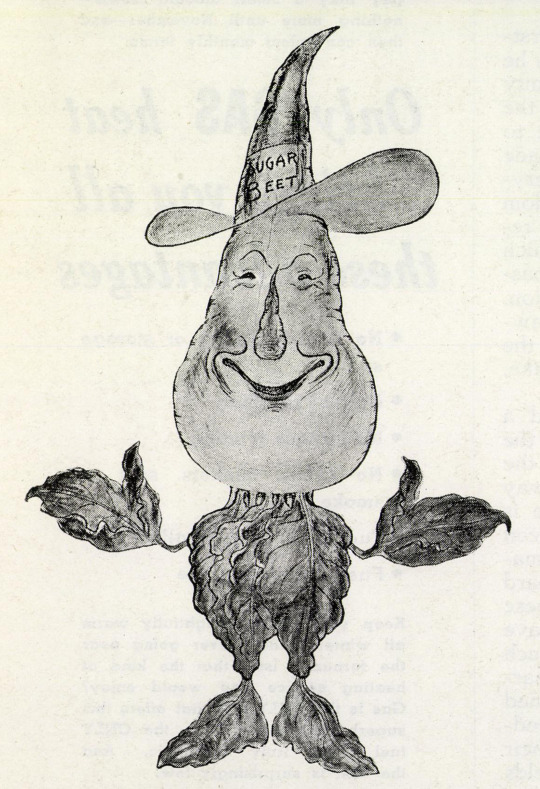
Source details and larger version.
Vegetable people, vegetarian nightmares, vegetable hell, giant vegetables … my collection of vintage vegetables is growing.
45 notes
·
View notes
Text

The Swiss Chard is so eye catching that you sometimes see them among ornamental flowers in garden borders, but they really belong in the vegetable garden. Our kitchen garden has its own display of multicoloured Swiss Chard (Beta vulgaris). Many of our familiar leafy greens all belong to this single species despite their diverse tastes and physical appearances. Swiss Chard, Beetroot, Perpetual Spinach, Sugar Beet, and Manglewurzel (a leaf and root crop grown as animal feed) are all Beta vulgaris. The wild ancestor of all these useful plants is the Sea Beet (Beta vulgaris subspecies maritima), a plant that grows at the seaside all over Europe and Western Asia. The Sea Beet had been domesticated and bred for leaf-bearing or root-bearing cultivars by the time of the Ancient Egyptians. The jewel-like colours of beet roots and chard stems comes from Betalain pigments instead of anthocyanins. Medical studies have shown that these natural phytonutrient pigments have anti inflammatory and antioxidant properties when consumed. These plants not only brighten up your plate and garden, but also light the path to better health!
#swiss chard#red beets#sugar beet#spinach#anthocyanin#pigments#edible plants#katia plant scientist#plant science#plant scientist#plant biology#plants#plant aesthetic#plantblr#kitchen garden#vegetables#fruits and vegetables#grow your own food#leafy greens#healthy food#botany#colorful#red and green#phytonutrients
13 notes
·
View notes
Text
From this main root axis, lateral roots develop to form an extensively branched root system (Figure 5.8).

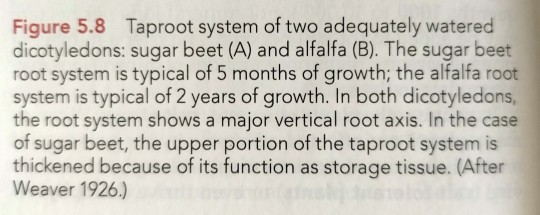
"Plant Physiology and Development" int'l 6e - Taiz, L., Zeiger, E., Møller, I.M., Murphy, A.
#book quotes#plant physiology and development#nonfiction#textbook#root system#dicot#dicotyledon#eudicots#sugar beet#alfalfa#taproot#plant growth#soil water#groundwater
3 notes
·
View notes
Text
Sugar Beet Research : £1M Project to Leverage Gene-Editing
Key Takeaways:
A collaborative effort between British Sugar, Tropic, and the John Innes Centre receives significant funding to address virus yellows disease in sugar beets.
The project is supported by Innovate UK’s Farming Futures R&D Fund and Defra’s Farming Innovation Programme, highlighting a strategic approach to agricultural innovation.
A total project budget of £1m, with £663,443 grant…

View On WordPress
0 notes
Link
1 note
·
View note
Text
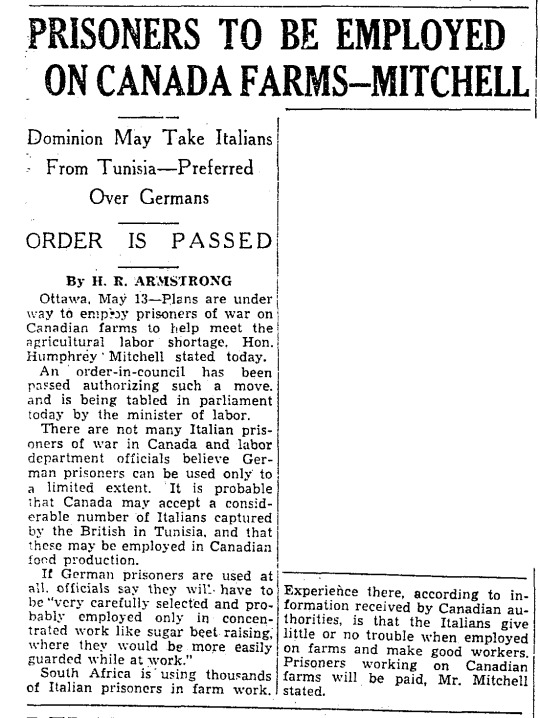
"PRISONERS TO BE EMPLOYED ON CANADA FARMS-MITCHELL," Toronto Star. May 13, 1943. Page 2.
---
Dominion May Take Italians From Tunisia - Preferred Over Germans
----
ORDER IS PASSED
---
By H. R. ARMSTRONG
----
Ottawa, May 13 - Plans are under way to employ prisoners of war on Canadian farms to help meet the agricultural labor shortage, Hon. Humphrey Mitchell stated today.
An order-in-council has been passed authorizing such a move. and is being tabled in parliament today by the minister of labor.
There are not many Italian prisoners of war in Canada and labor department officials believe German prisoners can be used only to a limited extent. It is probable that Canada may accept a considerable number of Italians captured by the British in Tunisia, and that these may be employed in Canadian food production.
If German prisoners are used at all officials say they will have to he "very carefully selected and probably employed only in concentrated work like sugar beet raising, where they would be more easily guarded while at work."
South Africa is using thousands of Italian prisoners in farm work.
Experience there, according to information received by Canadian authorities, is that the Italians give little or no trouble when employed on farms and make good workers. Prisoners working on Canadian farms will be paid, Mr. Mitchell stated.
#agricultural workers#agricultural crisis#italian prisoners#prisoners of war#manpower shortage#tunisian campaign#tobacco harvest#sugar beet#farming in canada#canada during world war 2#labour shortage#farm workers
0 notes
Text
In leaves of plants such as sugar beet and tobacco, the ability to accumulate exogenous sucrose in the sieve element-companion cell complex is acquired as the leaves undergo the sink-to-source transition, suggesting that the symporter required for loading has become functional.
"Plant Physiology and Development" int'l 6e - Taiz, L., Zeiger, E., Møller, I.M., Murphy, A.
#book quote#plant physiology and development#nonfiction#textbook#leaves#plant cells#sugar beet#tobacco#sieve elements#companion cells#sucrose#sink to source#source to sink#loading#symporter
0 notes
Text
Napoleon talks about the changes in the sugar and indigo industry
“Arts and manufactures,” said he [Napoleon] “are its legitimate province, and it is destined to make as great a revolution in the affairs of the world as that already accomplished by the magnet. Before the discoveries of Vasco de Gama pastel was a valuable blue dye, and in France produced a considerable revenue to the State: it was supplanted by indigo, which at that period was found to be a better dye. Chemistry has restored the use of the European product, which is now prepared in France of a much better quality and lower price than the very best foreign indigo. Sugar is also now manufactured in France as good and as cheap from beet root (both red and white) as the best foreign sugar from the cane, and in 1814 a sufficiency was produced in France for the consumption of France.”
Observing an involuntary smile on my countenance he added: “I know that the idea has been ridiculed in England, and even in France it is but little understood or acknowledged: they fancy that the French sugar which they purchase is really imported from the West Indies, but I had the means of knowing the fact, and I also know that even in flavor they are not distinguishable from each other—latterly I made use of no other.” I endeavoured to apologize for my smile by observing that “if they were still incredulous even in France, it was not wonderful that I should have been equally uninformed.”
— Quotes by Napoleon in Colonel Wilks and Napoleon: Two Conversations held at St. Helena in 1816, pg. 24
#sugar beet#sugar#Colonel Wilks#napoleon#napoleonic era#napoleonic#napoleon bonaparte#first french empire#french empire#indigo#sugar cane#france#history#19th century#beet sugar#cane sugar#industrial revolution#economics#economic history#french history#pastel
13 notes
·
View notes
Text

0 notes
Text
I live in a city where there's a sugar beet Factory.
I hated it my whole life. It stinks up the whole city. And they basically don't have to pay for anything except for a few people who will live around the plant even though the whole city suffers. I think it should be a law anybody or any company that does something like this that the people who make the most profit from the company have to suffer the consequences of their actions. They never really do do they? Do you really think the person who owns the company ever actually smells the smell from their own home? I bet you they live at least two cities away.
1 note
·
View note
Text


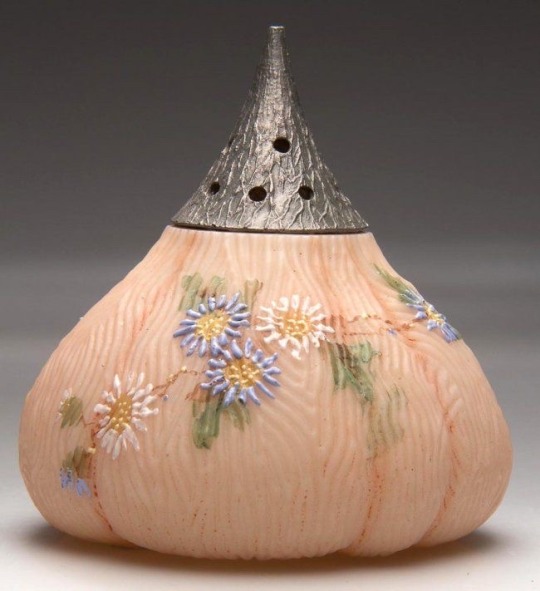
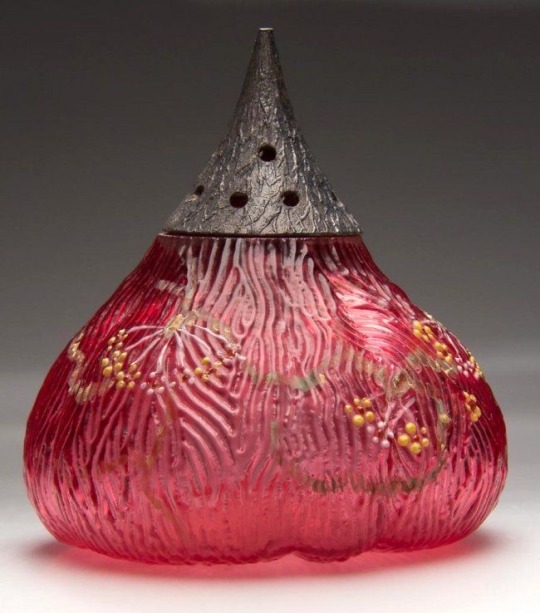






#mount washington#sugar shakers#they’re called fig or beet usually but i know garlic nation will claim these#salt and pepper shakers#shakers
373 notes
·
View notes
Text
Figure 11.18 diagrams the several possible pathways in sinks. Both unloading and the short-distance pathway appear to be completely symplastic in some eudicot leaves, such as sugar beet and tobacco (see Figure 11.18A). (...) While symplastic import predominates in most sink tissues, part of the short-distance pathway is apoplastic in some sink organs at some stages of development – for example, in fruits, seeds, and other storage organs that accumulate high concentrations of sugars (see Figure 11.18B). (...) The apoplastic step could be located at the site of unloading itself (Type 1 in Figure 11.18B) or farther removed from the sieve elements (Type 2). (...) Sugars exit the sieve elements (phloem unloading) via a symplastic pathway and are transferred from the symplast to the apoplast at some point removed from the sieve element-companion cell complex (Type 2 in Figure 11.18B).

"Plant Physiology and Development" int'l 6e - Taiz, L., Zeiger, E., Møller, I.M., Murphy, A.
#book quotes#plant physiology and development#nonfiction#textbook#phloem#unloading#symplast#apoplast#sink to source#sugars#sugar beet#tobacco#fruits#seeds#sieve elements#companion cells#plant cells
0 notes